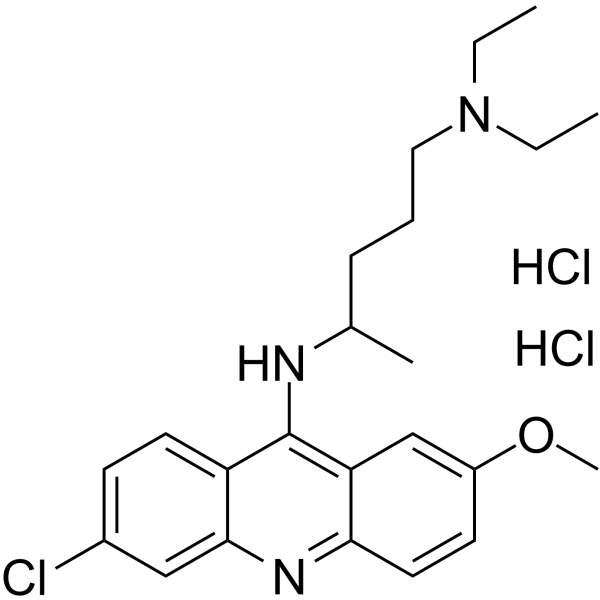上海金畔生物科技有限公司为生命科学和医药研发人员提供生物活性分子抑制剂、激动剂、特异性抑制剂、化合物库、重组蛋白,专注于信号通路和疾病研究领域。
Quinacrine dihydrochloride (Synonyms: 阿的平; Mepacrine dihydrochloride; SN-390 dihydrochloride) 纯度: 99.01%
Quinacrine (Mepacrine) dihydrochloride 是一种有效的,具有口服活性的抗疟剂 (antimalarial),在体内外均具有抗肿瘤作用。Quinacrine dihydrochloride 抑制 NF-κB 并激活 p53 信号转导,诱导肿瘤细胞发生凋亡 (apoptosis)。

Quinacrine dihydrochloride Chemical Structure
CAS No. : 69-05-6
| 规格 | 价格 | 是否有货 | 数量 |
|---|---|---|---|
| Free Sample (0.1-0.5 mg) | Apply now | ||
| 10 mM * 1 mL in DMSO | ¥605 | In-stock | |
| 100 mg | ¥550 | In-stock | |
| 500 mg | ¥980 | In-stock | |
| 1 g | 询价 | ||
| 5 g | 询价 |
* Please select Quantity before adding items.
Quinacrine dihydrochloride 相关产品
•相关化合物库:
- Drug Repurposing Compound Library Plus
- Clinical Compound Library Plus
- Bioactive Compound Library Plus
- Anti-Infection Compound Library
- Apoptosis Compound Library
- NF-κB Signaling Compound Library
- Anti-Cancer Compound Library
- Clinical Compound Library
- Autophagy Compound Library
- Anti-Aging Compound Library
- Drug Repurposing Compound Library
- Orally Active Compound Library
- FDA Approved & Pharmacopeial Drug Library
- Antiparasitic Compound library
- Mitochondria-Targeted Compound Library
- Rare Diseases Drug Library
| 生物活性 |
Quinacrine (Mepacrine) dihydrochloride is an orally bioavailable antimalarial agent, which possess anticancer effect both in vitro and vivo. Quinacrine dihydrochloride suppresses NF-κB and activate p53 signaling, which results in the induction of the apoptosis[1]. |
||||||||||||||||||||||||
|---|---|---|---|---|---|---|---|---|---|---|---|---|---|---|---|---|---|---|---|---|---|---|---|---|---|
| 体外研究 (In Vitro) |
Quinacrine (5-20 μM; 24 hours) inhibits the growth of SGC-7901 cells[1]. 上海金畔生物科技有限公司 has not independently confirmed the accuracy of these methods. They are for reference only. Cell Viability Assay[1]
Apoptosis Analysis[1]
Western Blot Analysis[1]
|
||||||||||||||||||||||||
| 体内研究 (In Vivo) |
Quinacrine (100 mg/kg three times per week for two consecutive weeks) significantly suppresses circulating blast cells at days 30/31 and increases the median survival time (MST). Quinacrine does not decrease the body weight of treated animals at the tested dose[2]. 上海金畔生物科技有限公司 has not independently confirmed the accuracy of these methods. They are for reference only.
|
||||||||||||||||||||||||
| Clinical Trial |
|
||||||||||||||||||||||||
| 分子量 |
472.88 |
||||||||||||||||||||||||
| Formula |
C23H32Cl3N3O |
||||||||||||||||||||||||
| CAS 号 |
69-05-6 |
||||||||||||||||||||||||
| 中文名称 |
奎纳克林二盐酸盐;阿的平;米帕林 |
||||||||||||||||||||||||
| 运输条件 |
Room temperature in continental US; may vary elsewhere. |
||||||||||||||||||||||||
| 储存方式 |
4°C, sealed storage, away from moisture *In solvent : -80°C, 6 months; -20°C, 1 month (sealed storage, away from moisture) |
||||||||||||||||||||||||
| 溶解性数据 |
In Vitro:
DMSO : ≥ 44 mg/mL (93.05 mM) H2O : 13.89 mg/mL (29.37 mM; Need ultrasonic) * “≥” means soluble, but saturation unknown. 配制储备液
*
请根据产品在不同溶剂中的溶解度选择合适的溶剂配制储备液;一旦配成溶液,请分装保存,避免反复冻融造成的产品失效。 |
||||||||||||||||||||||||
| 参考文献 |
|
所有产品仅用作科学研究或药证申报,我们不为任何个人用途提供产品和服务
